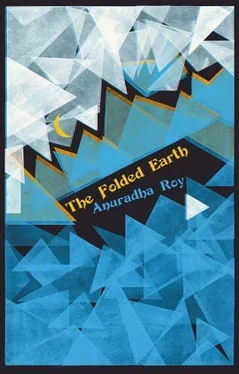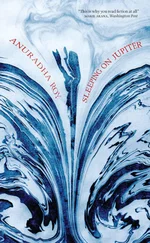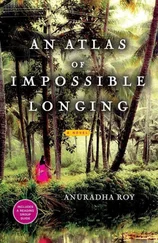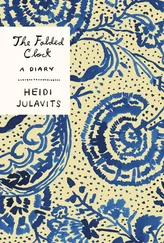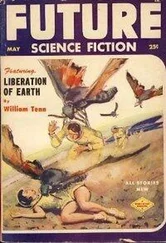I throw the pieces of paper in the air. The shreds that drift over me are almost indistinguishable from the white butterflies dipping over the wild flowers in this garden gone to seed.
The eagles are still watching me from the mile-high crook of a deodar tree. Around them the afternoon has begun its rapid wintertime decline and the sun’s long rays slide gently now, and give no warmth. I will need to get up from the grass before the chill seeps into my bones.
The eagles feel the change in air and light. The first of them flexes its talons like an athlete, spreads its wings and leaves its branch. The other is still looking in my direction. Eventually it turns its basilisk gaze away and follows its mate. The day is over, they have to hunt for a perch to sleep on now. They are lifted higher and higher by air currents as they wheel and arc and sail towards the last hill of the world.
arrack
liquor distilled from the fermented sap of toddypalms, or from fermented molasses, rice, etc.
babu
suffix added to men’s names to show respect; bureaucrat
barasinghas
Rucervus duvaucelii , a species of deer with great horns, native to India and Nepal
batasha
crunchy sugar candy
beedi
cheap cigarette made of tendu leaf and tobacco
beta
affectionate term for male child
bhajan
Hindu devotional song
bhang
preparation from the leaves and flowers (buds) of the female cannabis plant, smoked or consumed as a beverage
Binaca Geet Mala
a popular music programme on radio in the 1960s and ’70s.
biryani
richly flavoured rice cooked with meat, a speciality of Hyderabad
carrom
a game similar to billiards, but played without cues on a lacquered plywood board. Popular in India, Pakistan and Bangladesh
chacha
uncle (specifically, father’s younger brother)
chadar
long scarf
chaiwallah
man selling tea
charas
hashish hand-made from cannabis, which grows wild throughout the Himalaya
chikoo
Manilkara zapota, Sapota , a common soft fruit
chootiya
strongly abusive word for fool
chota bachha
small child
chote sahab
young master
chowkidar
watchman
coolie
porter
darshan
holy audience
dekchi
a large cooking vessel
Deo Bhoomi
land of the Gods
Diwali
festival of lights celebrated everywhere in India
dosa
a pancake native to South India, made from a fermented batter of ground rice and lentil
dupatta
long scarf worn by women
durbar
court
firanghi
foreigner
ghee
clarified butter used in cooking and in rituals; also in cremations
gitti
a game played with five stones, similar to jacks
gongura
a sour, leafy vegetable found in South India
gutka
an addictive mix of crushed betel nut, tobacco, catechu and lime, sold in foil packets
half-sari
a full-length skirt and fitted blouse, combined with a long scarf, commonly worn by girls in South India
hawai chappals
rubber flip-flops
hum
we
jaggery
solid molasses
jalebi
a pretzel-shaped Indian sweet, both crisp and juicy with syrup when freshly fried
jhadu
broom
kheer
creamy rice pudding often flavoured with nuts and cardamom
khidmatgar
bearer or valet; a servant
kumkum
coloured powder used to decorate or anoint the forehead
kurta
long shirt
kutala
a digging implement with a curved blade
langur
monkeys of the genus Semnopithecu , widespread in South Asia
machan
improvised tree loft to hunt or watch animals from
madua
millet
mandi
wholesale market
murukku
a fried snack from South India
namaste
common Indian way of greeting anyone, by joining the palms
nilgai
literally, blue bull; Boselaphus tragocamelus , a large antelope
paan
betel leaf folded with areca nut, tobacco and other condiments, usually consumed after meals
paapam
Telugu expression meaning “You poor thing”
pakoras
vegetable fritters
papad
poppadum
poori-aloo
cheap, streetside meal made up of deep-fried Indian bread and potatoes
pugree
turban
roti
thin wholewheat bread baked every day, a staple food
sadhu
wandering holy man, mendicant
sala
bastard
salwar kameez
combination of a long shirt ( kameez ) and loose trousers ( salwar ) commonly worn by Indian women
samosas
deep-fried, triangular pastry filled with spicy vegetables
sanki
half-witted
shikari
hunter
sindoor
the red colouring in the parting of a married woman’s hair
sola topi
pith helmet worn in colonial times
thataiyya
Telugu for grandfather
theek
alright/well
tum
you
D. C. Kala, Amit Sen, and Ravi Dayal decoded the hills for me. Their erudition, wit, and individualism, their ability to combine austerity with pleasure, make them a unique Himalayan species now extinct.
Something Arundhati Gupta said started off this book. She also read its first draft as did Myriam Bellehigue, Sheela Roy, Shruti Debi, and Partho Datta. Rukun Advani suffered countless drafts and demands, and there is a lot of his writing and thinking between the lines. Christopher MacLehose, with his idiosyncratic genius, worked on successive versions as he would on an unmade garden: a space to inhabit, plant ideas in, and over time grow into a book.
Manju Arya’s insights have provided much entertainment and education. Mahiraj Mehra’s doctoral work on Ranikhet was a rich source of information, as were conversations with S. Ramesh and Akshay Shah. I have benefited from Janet Morgan’s Edwina Mountbatten: A Life of Her Own , Martin Booth’s Carpet Sahib , D. C. Kala’s Jim Corbett of Kumaon , and P. N. Dhar’s Indira Gandhi, the Emergency and Indian Democracy . Another delight was The Social Economy of the Himalayans , by S. D. Pant, which arrived out of the blue from MacLehose Press. The book is an example of the many overwhelming kindnesses of Christopher, Koukla, and Miska MacLehose, who break every cliché there is about the cruel impersonality of modern publishing. As do many others at MacLehose Press and Quercus, especially Katharina Bielenberg and Nicci Praca.
Ivan Hutnik and Thomas Abraham’s involvement in this book are fortuitous culminations of old friendships. Nasreen Kabir, Radhika Prakash, and Manishita Das will as always shelter me through its publication. To each of them I am ever grateful.
